
Honda CR-Z Minor Model Change (MMC)
Launched in Japan three years ago, the CR-Z is now undergoing its first MMC (Minor Model Change). As normal, this MMC was first launched in Japan late last year and is now making an early debut across ASEAN, with the MMC for Malaysia launching late last month on the 21st of February. The version of the CR-Z MMC being launched for ASEAN is the same as the JDM version except for some specification changes to suit local markets. An example of this specification change would be the removal of the ~180kph speed limiter found in JDM cars - Honda specified the ASEAN CR-Z MMC to have a top speed of ~200kph.
To be honest, response to the CR-Z has been rather erratic since its launch. It sold well in some countries, like its home market in Japan or here in Malaysia for e.g. But in other countries, like the U.S. which is the world's biggest sports cars market, it had lack-lustre sales. Nevertheless, despite its turbulent reception, total worldwide sales of the CR-Z has by now exceeded 70,000 units, which is actually a very good result for a supposedly niche market limited appeal 2-door 'hot hatch' / 'sports coupe'.
More specifically for us here however, the CR-Z did not have universally good reception from Honda's steadily dwindling legion of hardcore enthusiast fans. A large part of this centers on the expectation that, rightfully or not, it promised to be a successor to the legendary EF-CRX of the 1990s but doesn't have the charisma or outright performance to deliver on that promise. More specifically, negative comments on the CR-Z focussed mainly on the engine and suspension. The 1.5l SOHC i-VTEC IMA delivered 124ps and while sufficient for normal car owners, is really not sufficient for the expectations of hardcore enthusiasts used to the legendary DOHC VTEC and DOHC i-VTEC of old - legends like the B16A and B18C not to mention the Type-R engines. The suspension configuration based on front struts and rear torsion beam was also regularly criticised mainly for its limited capability for outright performance.
While the suspension cannot be changed easily, the powertrain can. And it would actually be a trivial task for Honda's R&D engineers from the older times - like a couple of decades or more ago. In this case, the LPL or chief engineer for the CR-Z is a 40 year old Honda veteran so he should be more than up to the task. And so too, the powertrain has been quite significantly upgraded for this MMC. In this review, I will highlight all of the more significant changes of the MMC which was explained during the technical presentation at the launch event.
In addition, I will also offer my own thoughts on a couple of details which I will highlight in red italic fonts, to differentiate them from the actual contents from the presentation.
Design Objectives in the MMC
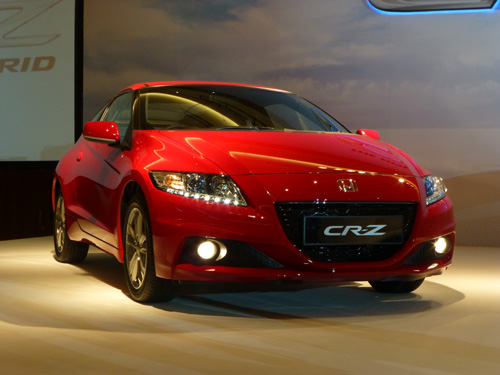
The original vision of the CR-Z emphasizes three elements:- Honda DNA which was explained as Fun Driving, i.e. the 'Joy of Driving'; Social Consideration i.e. the concept of an 'environmentally friendly performance (car)'; and "Enjoy Daily Life", i.e. a sporty car that is enjoyed in normal daily driving.
The changes in this MMC builds upon these three original concepts. The CR-Z LPL described the MMC objective as a single "More Hybrid Sports", japanese-english speak for focus now being on the 'sports' part of the CR-Z, versus the more fuel economy focus of the pre-MMC original. I.e. this MMC strives to make the CR-Z more 'sporty', the cavert here being that 'sporty' is as defined by Honda, not us Honda customers.
Honda classifies the new 'more sportiness' into two main elements. First is to inject "More Sports" (the term used in Honda's presentation) into the CR-Z which is actually to give the CR-Z more "stylish looks" (thus my point that the term 'sporty' being used here is "in Honda's own opinion").
The other element of this 'more sportiness' is characterized by Honda as "More Fun Performance". This time we are talking about the real McCoy - performance as in speed, handling, etc. However the keyword here is 'fun', i.e. performance targetted at making the daily driving experience more 'fun', instead of outright performance like dominance of the competition in a race event like a Gymkhana for instance. Understanding this viewpoint is important to understanding the use of the word 'performance' in the context of this MMC.
Honda used three key enablers to deliver on the promises of the MMC; a 'new' 1.5l (SOHC) i-VTEC with 'Lo-Hi' (Honda's terminology) VTEC + IMA, a new Lithium Ion (LiOn) Battery (and ancilliary system like IMA electric motor), and the new "Plus-Sport System" a feature delivering something like KERS in F1 (but not exactly like KERS).
Each of these enablers will be covered in more detail later in this article. But first, the key changes in the exterior and interior design which delivers on the first part of "More Sports" element above.
Exterior Updates
The goal when updating the exterior design of the CR-Z for this MMC was to create a 'more cool looking' (term used by the Honda presenter at the launch event) car without changing the original design language. Therefore there have been no major change to the exterior design, and the sleek lines of the car remains unchanged.
Changes are on the finer details of the exterior and are as follows: a new polished dark (coloured) mesh grill, clear blue lens for the headlights, a 'highlight' for each headlight consisting of a strip of 8 LEDs on the lower edge offering a visual effect much like DRLs (Daylight Running Lights) popular on 'continental' (European) cars like Audi, a revised front bumper, and finally a revised rear diffusor (bottom of the rear bumper for those unfamiliar with the term).
 | 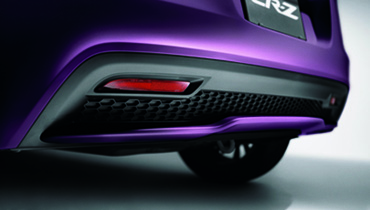 | 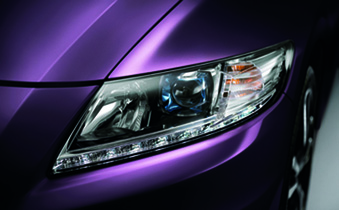 |
Interior Updates
Honda characterizes the updates to the interior as being to create a 'Sharp and Precise Interior'. The MMC emphasize on the use of 'brilliant film', a new red-based interior color scheme, and revised seats.
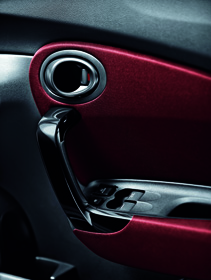 |  | 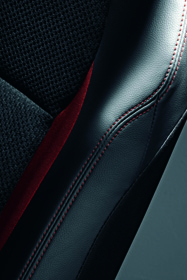 |
'Brilliant Film' used by Honda in this MMC refers to the use of chrome type accents to provide contrast to make the interior more stylish looking. On the doors for e.g, attention was focussed on the interior. A bottle holder has been added and a 'brilliant film' chrome-coated ring is added to the door speaker covers and other places to offer a 'more valued sense' (Honda speak). The door lining material is now a cuticle-urethane laminite which Honda says offers a 'more valued and touching feel' (a not entirely meaningful phrase which I think was translated too literally from the original japanese phrase).
The interior spots a new colour scheme with a purpose to emphasize the sporty image of the MMC CR-Z and is now based on a black and red colour combination with dark silver garnish (the 'brilliant film' again) for highlights.
Finally, while the seat's basic design remains the same, but the seat material is now a combination of synthetic leather and fabric and like the Honda City MMC, red stitching is used to add accentuation to the seat.
Powertrain Updates

The powertrain received the biggest update for this MMC, with a focus on delivering more performance through a more powerful higher revving engine as well as creating an IMA system with more capacity - a greater reserve which can deliver assist for longer duration. Improvements are focussed on three areas below.
Engine
The original LEA engine which was a 12V-16V VTEC type implementation has been changed to a 'high rev type' L-Series with a 'Lo-Hi VTEC' implementation. This means full time 16V operation with a low and high cam profile setup for the intake side. The redline is now raised by 400rpm to 6,600rpm (this is Honda's definition for 'high revving' nowadays). In addition, the crankshaft is now made up of higher density metal.
This new engine is configured for max power of 118ps when used with CVT and 120ps when used with 6MT.
IMA System
The IMA System has been completely upgraded and is now based on Lithium Ion (LiOn) technology instead of the original Nickel Metal Hydride (NiMH) technology. Both types of battery offers quite good tolerance to the charging 'memory effect' problem affecting rechargeable batteries. But comparing the two, for the same amount of charge storage, Li-On batteries are physically smaller and thus lighter than NiMH and operates at higher voltage. According to japanese manufacturer Hitachi, Li-On cells can also be charged and discharged more rapidly without suffering from the "memory effect" as much as NiMH cells does. However, other sources also claims that LiOn batteries don't last as long in extreme temperatures, particularly in very hot climates (note : ASEAN in general).
TOVA Notes: Concerns about the IMA battery reliability has been the bane of IMA hybrid cars ever since their introduction, with Honda having even suffered a few court cases over IMA battery claims so this is something for potential owners to take note of.
The pre-MMC CR-Z uses a NiMH 100V battery with a max power rating of 13kW though configured to deliver a max of 10kW in operation. Physically the old battery occupies 39.7 litres and weighs 20.2kg. It is made up of 83 1.2V cylindrical NiMH battery cells.
The new battery is a Lithium Ion 144V battery with max power of 18.8kW and configured to deliver a max of 15kW in operation. Physical volume of this new battery is 36.6L while weight is also 20.2kg. Thus this new battery offers 44% increase in both voltage and power rating while its size has been decreased 3%. Weight is unchanged. The battery pack itself is constructed from 40 3.6V square LiOn battery cells.
For the MMC, Honda basically went for the same IMA battery pack size and weight, but using LiON's advantage to store more charge.
Transmission
The two transmission choices of 6MT and CVT-7 are retained for this MMC. The CVT has been updated by adding both Oil temperature and Oil pressure sensors to improve its reliability and durability. For the 6MT, to cope better with the higher torque of the new engine+IMA motor, the clutch size has been increased.
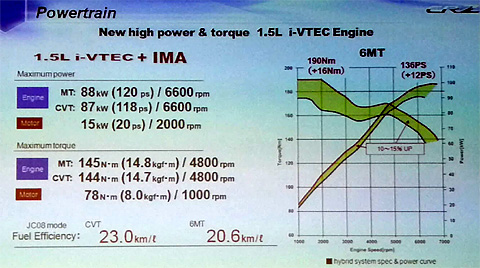 The new powertrain (engine+IMA motor) delivers outstanding high torque at very low rpms where
regular gasoline
engines tends to struggle, as well as significantly higher power. For the 6MT, the powertrain
is now rated at 136ps, up 12ps from the pre-MMC. Torque now tops out at a max of 190Nm (up 16Nm),
flat over a 1,000rpm range from 1,000-2,000rpm. Power and torque in the mid-high
rpm are also increased between 10-15% on the old powertrain.
The new powertrain (engine+IMA motor) delivers outstanding high torque at very low rpms where
regular gasoline
engines tends to struggle, as well as significantly higher power. For the 6MT, the powertrain
is now rated at 136ps, up 12ps from the pre-MMC. Torque now tops out at a max of 190Nm (up 16Nm),
flat over a 1,000rpm range from 1,000-2,000rpm. Power and torque in the mid-high
rpm are also increased between 10-15% on the old powertrain.
For the CVT version, the powertrain has been detuned to deliver lower power and torque. It is spec'ed to deliver 135ps at 6,600rpm while max torque is lowered to 172Nm but now flat over a 2,000rpm range from 1,000 to 3,000rpm.
While delivering all these extra power and torque, the fuel efficiency for this MMC CR-Z is actually improved to 23 km/l for the CVT version and 20.6 km/l for the 6MT version, tested using the japanese JC08 mode.
There was an event prior to the launch which unfortunately I did not attend so basically I cannot attest to the absolute accuracy of the following information. According to a journalist friend whom attended that event, apparently Honda says the purpose of the powertrain detune for the CVT version is to 'protect' the CVT belt. Honda acheived this by putting a more restrictive exhaust on the engine. Now, any enthusiast worth his or her salt knows that 'exhaust' actually comprises several components like header, catalytic converter, resonator (what some calls the mid-box), the exhaust piping, the muffler and so forth. So, which part of the exhaust was changed ? The LEA engine has an integrated header (part of the cylinder head) so I believe it is the exhaust piping, resonator and muffler what has been changed. Supposedly, Honda went as far as to admit during questioning that for owners of the MMC CVT CR-Z, you can get back all the lost power and torque - getting the same for the 6MT version - simply by replacing the exhaust system with that from the 6MT version. Of course enthusiasts seldom go so small a step. But the interesting question is what will Honda do about the issue of warantty in such cases since basically all parts used here are still original stock Honda parts. Personally I think Honda will surely make a big fuss and will make claims that the 'modification' may impact the durability of the CVT gearbox which usually is taken by Honda as being enough justification to void the warantty of the exhaust and its related parts (engine as well ?). So use the info here at your own risk.
Performance Improvements from the Powertrain Updates
Together, the new engine and IMA system - the powertrain - enables a higher outright performance from the MMC CR-Z compared to the original pre-MMC version.
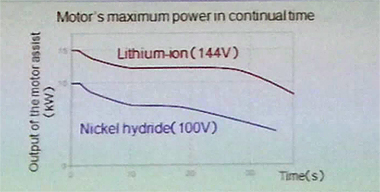 The new LiOn battery can deliver a higher percentage its max power for
slightly longer period of time. In maximum discharge mode, the LiOn battery will last a
few seconds longer compared to the NiMH battery. Of more significance is the higher sustained
discharged rate and the graph on the right, taken from the presentation, shows this.
The new LiOn battery can deliver a higher percentage its max power for
slightly longer period of time. In maximum discharge mode, the LiOn battery will last a
few seconds longer compared to the NiMH battery. Of more significance is the higher sustained
discharged rate and the graph on the right, taken from the presentation, shows this.
In practice, this greater capacity translates directly to an ability to sustain more WOT runs. According to Honda's own tests, from full charge to min battery charge (where IMA assist becomes minimal), the new LiOn battery is able to support up to 9 consecutive WOT standing start accelerations to 80kph while the original NiMH battery pack will only support 4 runs before going into discharged state.
In the 0-100kph standing start acceleration, Honda rates the MMC CR-Z for a time of around 8.8 seconds for the 6MT and 9.5 seconds for the CVT. This compares very favourably to the pre-MMC model which Honda rates at 10 seconds for the 6MT and just over 10.5 seconds for the CVT. Honda emphasizes that this improved acceleration comes with improved fuel efficiency for the CVT while there has been no impact to the fuel efficiency for the 6MT.
TOVA's comments: The new 0-100kph standing start acceleration figures are quite impressive. Traditionally, Honda has always been conservative when quoting this figure in the past. For e.g. while they quoted 10 seconds for the pre-MMC 6MT CR-Z, I managed to obtain 9.5 seconds on my own tests, under real-life (i.e. less than ideal) conditions. For the pre-MMC CR-Z, the 0-100kph run is hampered by the gearing in 2nd which just tops out at 99kph at the rev-cut, necessitating a change to 3rd gear for that last 1kph. Without the penalty of the extra gearchange, the 0-60mph run for e.g. was done a full second faster at 8.5 seconds, with one U.S. magazine getting an even faster time of 8.3 seconds under ideal conditions. With this MMC, the engine has a 400rpm higher red-line so if gear ratios are left unchanged, this means that 100kph can now be reached in 2nd gear. So given that Honda now quotes less than 9 seconds for the MMC CR-Z 6MT, I think chances are good that we might see a sub 8-seconds stock CR-Z ! This is sometime I am eager to find out when I get the car for review.
Brand-new PLUS SPORT (+S) system
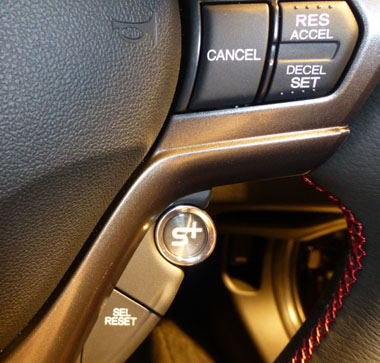
The MMC CR-Z is now fitted with a brand new 'Plus Sport' (+S) mode to enhance its driving performance. This +S mode is activated via a button located on the right hand side of the steering wheel, below the wheel spoke. When activated, +S offers full throttle opening at lower throttle pedal positions, full Assist from the IMA system, and on the CVT variant, a high gear change response (i.e. faster gear ratio ramp up on WOT).
In the technical presentation at the launch event, Honda says that a 'significant difference' can be experienced while accelerating on the highway and in the city and even went so far as to make a claim that +S mode on the new powertrain offers an 'acceleration feeling like V6 3.0 engine' ! A brave claim indeed.
This +S mode on the surface seems like the KERS system used in Formula-1 cars but in actuality is not. +S simply manipulates three main ECU parameters to offer an impression of greater power but in reality it is easier access to maximum power from the powertrain. The three main areas +S manipulates are as follows.
DBW
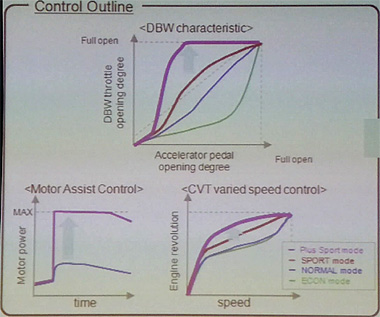
In normal operations, maximum throttle butterfly opening is acheived on WOT position on the throttle pedal. The difference between the three modes: E, D, and S are the intermediate butterfly opening positions - Sports mode offers more aggressive throttle openings - greater butterfly openings at lower throttle pedal positions while Drive and especially Econ mode gives milder openings. +S on the other hand, activates 100% throttle butterfly opening for throttle pedal positions starting from just below the 50% mark. Thereafter, further pedal position increases do not have any effect, as the throttle butterfly is already at max-open position. In operation, this gives the impression of a much more 'powerful' engine but actually it just enables max power delivery earlier.
IMA Assist
The second area +S manipulates is the IMA electric motor assist. Without +S, the IMA motor is never run at full capacity but +S mode will run the IMA electric motor at maximum assist for a short period of time upon WOT. In operation this means maximum torque is now available from the IMA system and combined with the more aggressive DBW operation, offers a very much greater power at lighter pedal positions. In this sense, +S do offer more torque but that is simply because battery assist is suppressed in non +S mode.
CVT gear ratio control
The third area +S manipulates applies to the CVT variant only. +S mode ramps up engine rpm faster and higher for moderate throttle pedal positions and the higher numerical gear ratio delivers greater pull from the driving wheels. This is much like what happens in S-mode only more aggresively.
TOVA's comments: I didn't have the chance to 'confront' Honda about the claim of "3.0l V6 torque" from the 'new' powertrain. The thing is, even with the more powerful IMA electric motor, the max torque for the powertrain is still only 190Nm and any enthusiast will know that a proper 3.0l V6 engine, at least one that is worth talking about, is definitely going to deliver a lot more than only 190Nm. In fact, even Honda's K24A DOHC i-VTEC delivers more than 190Nm of max torque. So what's the deal with this "3.0l V6 torque" claim ? It in fact is quite uncharacteristic of Honda to make this kind of claims. Personally, without being able to interrogate the LPL, my opinion is that he is referring to the low-rpm region, specifically the range from idle to maybe 2 or 3,000rpm. Now, even in an engine as large as 3.0l, the torque available at this low an rpm is still going to be less than 190Nm. But thanks to the IMA motor, the MMC CR-Z delivers 190Nm from idle right till 2,000rpm. So in this range, one might be justified in making a claim that the powertrain delivers '3.0l V6 levels of torque'. A good and careful enthusiast however would surely also quickly qualify the claim as 'in the range from idle to 2,000rpm'. This unfortunately Honda did not do, which in my opinion can open them up to criticism or even ridicule over this claim by unsymphathetic parties.
Closing
A 12ps increase in power is really not trivial and the +S mode also looks very interesting. To me personally, the CR-Z really should have been in this form right from the very beginning. Still, better late than never and on paper this MMC do give the CR-Z a very effective update to allow it to compete with its competitors more effectively. And apparently, based on what the LPL says in the press conference, he is planning for more of them in the future.
Honda won't tell me if there will be a media drive event for this MMC CR-Z perhaps planning it to be another exclusive one yet again. In any case, I am eagerly waiting for it to be made available for media loan test drives where I will definitely be subjecting it to my full suite of tests to see how much improvement it offers over the original CR-Z on the roads (where it matters most) and also how it stacks up against the current market competitors.
While we are still working to get our new servers and infrastructure up, if you would like to discuss or comment on the contents of this article, feel free to go over to our related post on our 'Honda Fan' blog and put your comments there. The link is http://tovahondafan.blogspot.com/2013/03/coverage-of-cr-zs-mmc-up-at-tova.html.
Visit TOVA on facebook
Wong KN
March 2013
© Temple of VTEC Asia
